fuel additives MERCEDES-BENZ E-Class WAGON 2012 W212 Owner's Manual
[x] Cancel search | Manufacturer: MERCEDES-BENZ, Model Year: 2012, Model line: E-Class WAGON, Model: MERCEDES-BENZ E-Class WAGON 2012 W212Pages: 396, PDF Size: 17.07 MB
Page 11 of 396
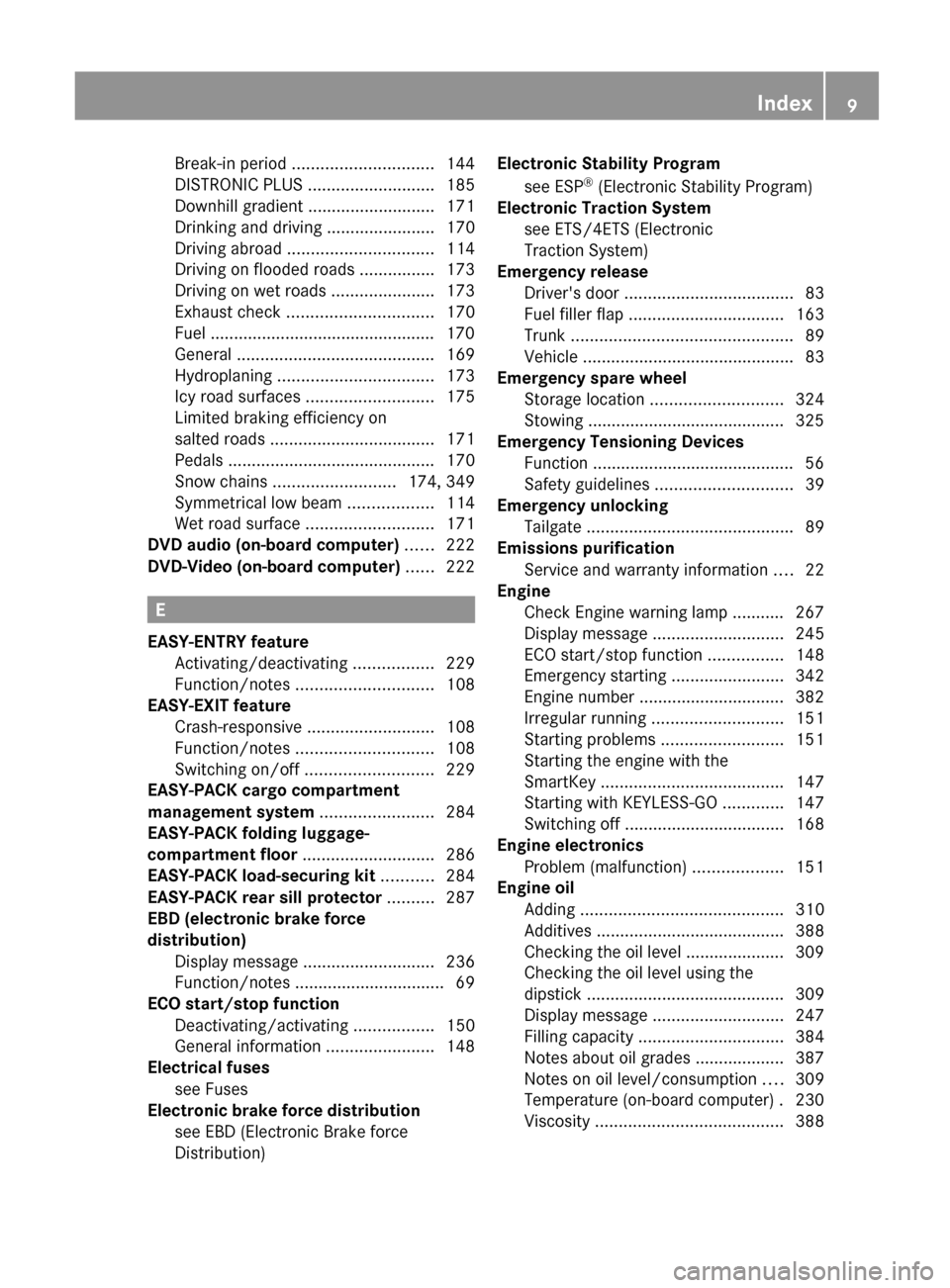
Break-in period .............................. 144
DISTRONIC PLUS ........................... 185
Downhill gradient ........................... 171
Drinking and driving .......................170
Driving abroad ............................... 114
Driving on flooded roads ................173
Driving on wet roads ......................173
Exhaust check ............................... 170
Fuel ................................................ 170
General .......................................... 169
Hydroplaning ................................. 173
Icy road surfaces ........................... 175
Limited braking efficiency on
salted roads ................................... 171
Pedals ............................................ 170
Snow chains .......................... 174, 349
Symmetrical low beam ..................114
Wet road surface ........................... 171
DVD audio (on-board computer) ...... 222
DVD-Video (on-board computer) ...... 222
E
EASY-ENTRY feature Activating/deactivating .................229
Function/notes ............................. 108
EASY-EXIT feature
Crash-responsive ........................... 108
Function/notes ............................. 108
Switching on/off ........................... 229
EASY-PACK cargo compartment
management system ........................ 284
EASY-PACK folding luggage-
compartment floor ............................ 286
EASY-PACK load-securing kit ........... 284
EASY-PACK rear sill protector .......... 287
EBD (electronic brake force
distribution) Display message ............................ 236
Function/notes ................................ 69
ECO start/stop function
Deactivating/activating .................150
General information .......................148
Electrical fuses
see Fuses
Electronic brake force distribution
see EBD (Electronic Brake force
Distribution)
Electronic Stability Program
see ESP ®
(Electronic Stability Program)
Electronic Traction System
see ETS/4ETS (Electronic
Traction System)
Emergency release
Driver's door .................................... 83
Fuel filler flap ................................. 163
Trunk ............................................... 89
Vehicle ............................................. 83
Emergency spare wheel
Storage location ............................ 324
Stowing .......................................... 325
Emergency Tensioning Devices
Function ........................................... 56
Safety guidelines ............................. 39
Emergency unlocking
Tailgate ............................................ 89
Emissions purification
Service and warranty information ....22
Engine
Check Engine warning lamp ........... 267
Display message ............................ 245
ECO start/stop function ................148
Emergency starting ........................342
Engine number ............................... 382
Irregular running ............................ 151
Starting problems ..........................151
Starting the engine with the
SmartKey ....................................... 147
Starting with KEYLESS-GO .............147
Switching off .................................. 168
Engine electronics
Problem (malfunction) ...................151
Engine oil
Adding ........................................... 310
Additives ........................................ 388
Checking the oil level ..................... 309
Checking the oil level using the
dipstick .......................................... 309
Display message ............................ 247
Filling capacity ............................... 384
Notes about oil grades ................... 387
Notes on oil level/consumption ....309
Temperature (on-board computer) . 230
Viscosity ........................................ 388Index9
Page 12 of 396
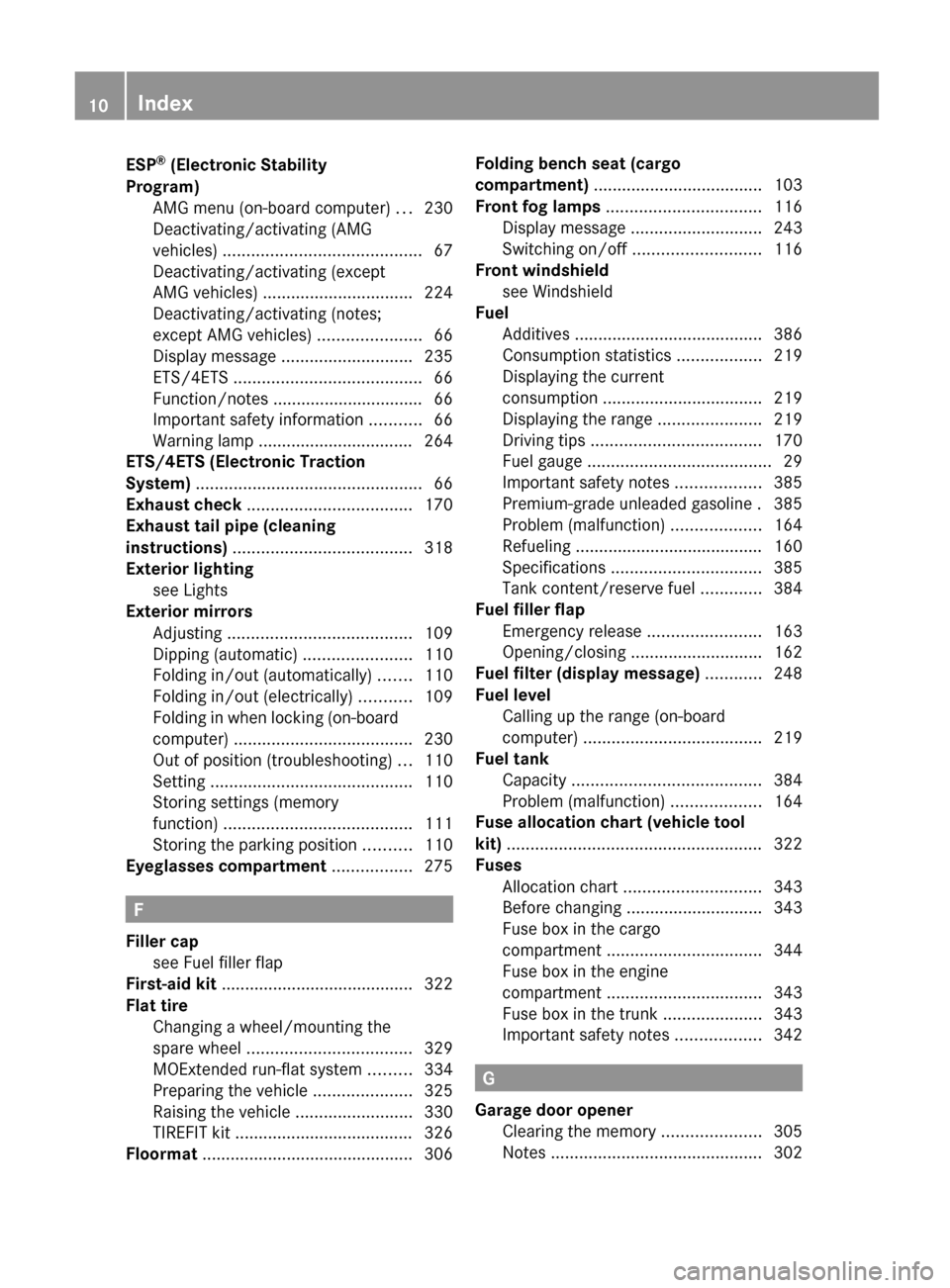
ESP®
(Electronic Stability
Program) AMG menu (on-board computer) ...230
Deactivating/activating (AMG
vehicles) .......................................... 67
Deactivating/activating (except
AMG vehicles) ................................ 224
Deactivating/activating (notes;
except AMG vehicles) ......................66
Display message ............................ 235
ETS/4ETS ........................................ 66
Function/notes ................................ 66
Important safety information ...........66
Warning lamp ................................. 264
ETS/4ETS (Electronic Traction
System) ................................................ 66
Exhaust check ................................... 170
Exhaust tail pipe (cleaning
instructions) ...................................... 318
Exterior lighting see Lights
Exterior mirrors
Adjusting ....................................... 109
Dipping (automatic) .......................110
Folding in/out (automatically) .......110
Folding in/out (electrically) ...........109
Folding in when locking (on-board
computer) ...................................... 230
Out of position (troubleshooting) ...110
Setting ........................................... 110
Storing settings (memory
function) ........................................ 111
Storing the parking position ..........110
Eyeglasses compartment ................. 275
F
Filler cap see Fuel filler flap
First-aid kit ......................................... 322
Flat tire Changing a wheel/mounting the
spare wheel ................................... 329
MOExtended run-flat system .........334
Preparing the vehicle .....................325
Raising the vehicle .........................330
TIREFIT kit ...................................... 326
Floormat ............................................. 306
Folding bench seat (cargo
compartment) .................................... 103
Front fog lamps ................................. 116
Display message ............................ 243
Switching on/off ........................... 116
Front windshield
see Windshield
Fuel
Additives ........................................ 386
Consumption statistics ..................219
Displaying the current
consumption .................................. 219
Displaying the range ......................219
Driving tips .................................... 170
Fuel gauge ....................................... 29
Important safety notes ..................385
Premium-grade unleaded gasoline . 385
Problem (malfunction) ...................164
Refueling ........................................ 160
Specifications ................................ 385
Tank content/reserve fuel .............384
Fuel filler flap
Emergency release ........................163
Opening/closing ............................ 162
Fuel filter (display message) ............ 248
Fuel level Calling up the range (on-board
computer) ...................................... 219
Fuel tank
Capacity ........................................ 384
Problem (malfunction) ...................164
Fuse allocation chart (vehicle tool
kit) ...................................................... 322
Fuses Allocation chart ............................. 343
Before changing ............................. 343
Fuse box in the cargo
compartment ................................. 344
Fuse box in the engine
compartment ................................. 343
Fuse box in the trunk .....................343
Important safety notes ..................342
G
Garage door opener Clearing the memory .....................305
Notes ............................................. 302
10Index
Page 18 of 396

Seat beltsAdjusting the driver's and front-
passenger seat belt .........................54
Adjusting the height ......................... 54
Belt force limiters ............................ 56
center rear-compartment seat .........55
Cleaning ......................................... 320
Correct usage .................................. 52
Emergency Tensioning Devices ........ 56
Fastening ......................................... 53
Important safety guidelines .............51
Releasing ......................................... 55
Safety guidelines ............................. 39
Special seat belt retractor ...............59
Switching belt adjustment on/off
(on-board computer) ......................229
Warning lamp ................................. 261
Warning lamp (function) ................... 55
Seats
Active multicontour seat ................102
Adjusting (electrically) ...................100
Adjusting the 4-way lumbar
support .......................................... 103
Adjusting the head restraint ..........100
Cleaning the cover .........................320
Correct driver's seat position ........... 98
Folding the backrest (rear
compartment) forwards/back .......280
Important safety notes ....................99
Seat heating problem ....................106
Seat ventilation problem ................106
Storing settings (memory
function) ........................................ 111
Switching seat heating on/off .......105
Switching seat ventilation on/off ..106
Sensors (cleaning instructions) ....... 317
Service see ASSYST PLUS service interval
display
Service interval display
Displaying service messages .........313
Hiding service messages ...............313
Notes ............................................. 313
Service messages ..........................312
Service menu (on-board computer) . 226
Service products Brake fluid ..................................... 388
Capacities ...................................... 384Coolant (engine) ............................ 389
DEF special additives .....................387
Engine oil ....................................... 387
Fuel ................................................ 385
Important safety notes ..................382
Refrigerant (air-conditioning
system) .......................................... 388
Washer fluid ................................... 389
Settings
Factory (on-board computer) .........230
On-board computer .......................226
Setting the air distribution ............... 137
Setting the airflow ............................ 137
SETUP (on-board computer) ............. 230
Side impact air bag ............................. 42
Side marker lamp (display
message) ............................................ 244
Side windows Convenience closing feature ............91
Convenience opening feature ..........91
Important safety information ...........90
Opening/closing .............................. 90
Problem (malfunction) .....................92
Resetting ......................................... 92
Skibag ................................................ 277
Sliding sunroof Important safety notes ....................93
Opening/closing .............................. 94
Problem (malfunction) .....................96
Resetting ......................................... 94
see Panorama roof with power
tilt/sliding panel
SmartKey
Changing the battery .......................78
Changing the programming .............77
Checking the battery .......................78
Convenience closing feature ............91
Convenience opening feature ..........91
Display message ............................ 259
Door central locking/unlocking .......74
Important safety notes ....................74
Loss ................................................. 80
Mechanical key ................................ 77
Positions (ignition lock) .................145
Problem (malfunction) .....................80
Starting the engine ........................147
Snow chains .............................. 174, 34916Index
Page 163 of 396
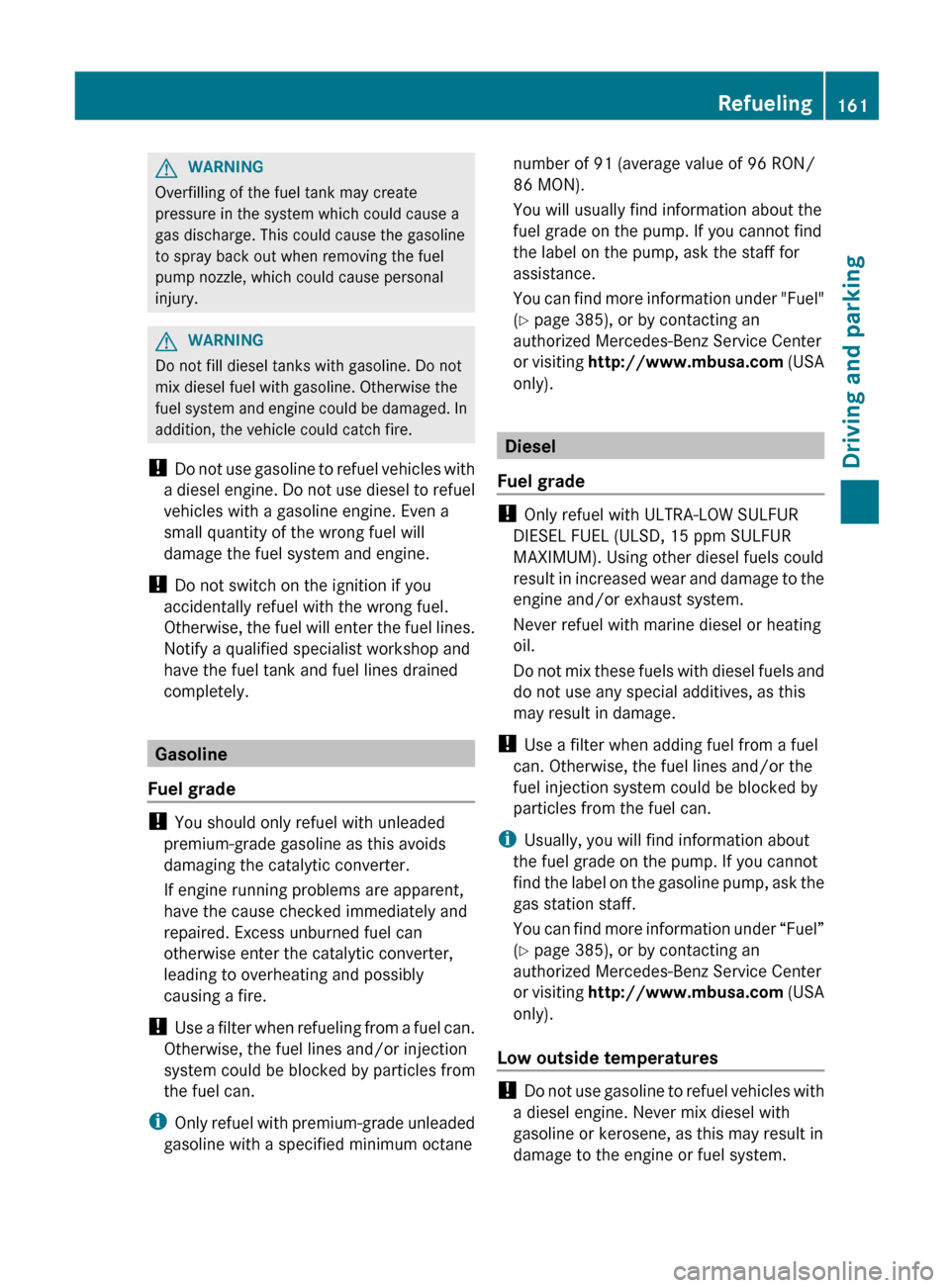
GWARNING
Overfilling of the fuel tank may create
pressure in the system which could cause a
gas discharge. This could cause the gasoline
to spray back out when removing the fuel
pump nozzle, which could cause personal
injury.
GWARNING
Do not fill diesel tanks with gasoline. Do not
mix diesel fuel with gasoline. Otherwise the
fuel system and engine could be damaged. In
addition, the vehicle could catch fire.
! Do not use gasoline to refuel vehicles with
a diesel engine. Do not use diesel to refuel
vehicles with a gasoline engine. Even a
small quantity of the wrong fuel will
damage the fuel system and engine.
! Do not switch on the ignition if you
accidentally refuel with the wrong fuel.
Otherwise, the fuel will enter the fuel lines.
Notify a qualified specialist workshop and
have the fuel tank and fuel lines drained
completely.
Gasoline
Fuel grade
! You should only refuel with unleaded
premium-grade gasoline as this avoids
damaging the catalytic converter.
If engine running problems are apparent,
have the cause checked immediately and
repaired. Excess unburned fuel can
otherwise enter the catalytic converter,
leading to overheating and possibly
causing a fire.
! Use a filter when refueling from a fuel can.
Otherwise, the fuel lines and/or injection
system could be blocked by particles from
the fuel can.
i Only refuel with premium-grade unleaded
gasoline with a specified minimum octane
number of 91 (average value of 96 RON/
86 MON).
You will usually find information about the
fuel grade on the pump. If you cannot find
the label on the pump, ask the staff for
assistance.
You can find more information under "Fuel"
( Y page 385), or by contacting an
authorized Mercedes-Benz Service Center
or visiting http://www.mbusa.com (USA
only).
Diesel
Fuel grade
! Only refuel with ULTRA-LOW SULFUR
DIESEL FUEL (ULSD, 15 ppm SULFUR
MAXIMUM). Using other diesel fuels could
result in increased wear and damage to the
engine and/or exhaust system.
Never refuel with marine diesel or heating
oil.
Do not mix these fuels with diesel fuels and
do not use any special additives, as this
may result in damage.
! Use a filter when adding fuel from a fuel
can. Otherwise, the fuel lines and/or the
fuel injection system could be blocked by
particles from the fuel can.
i Usually, you will find information about
the fuel grade on the pump. If you cannot
find the label on the gasoline pump, ask the
gas station staff.
You can find more information under “Fuel”
( Y page 385), or by contacting an
authorized Mercedes-Benz Service Center
or visiting http://www.mbusa.com (USA
only).
Low outside temperatures
! Do not use gasoline to refuel vehicles with
a diesel engine. Never mix diesel with
gasoline or kerosene, as this may result in
damage to the engine or fuel system.
Refueling161Driving and parkingZ
Page 168 of 396
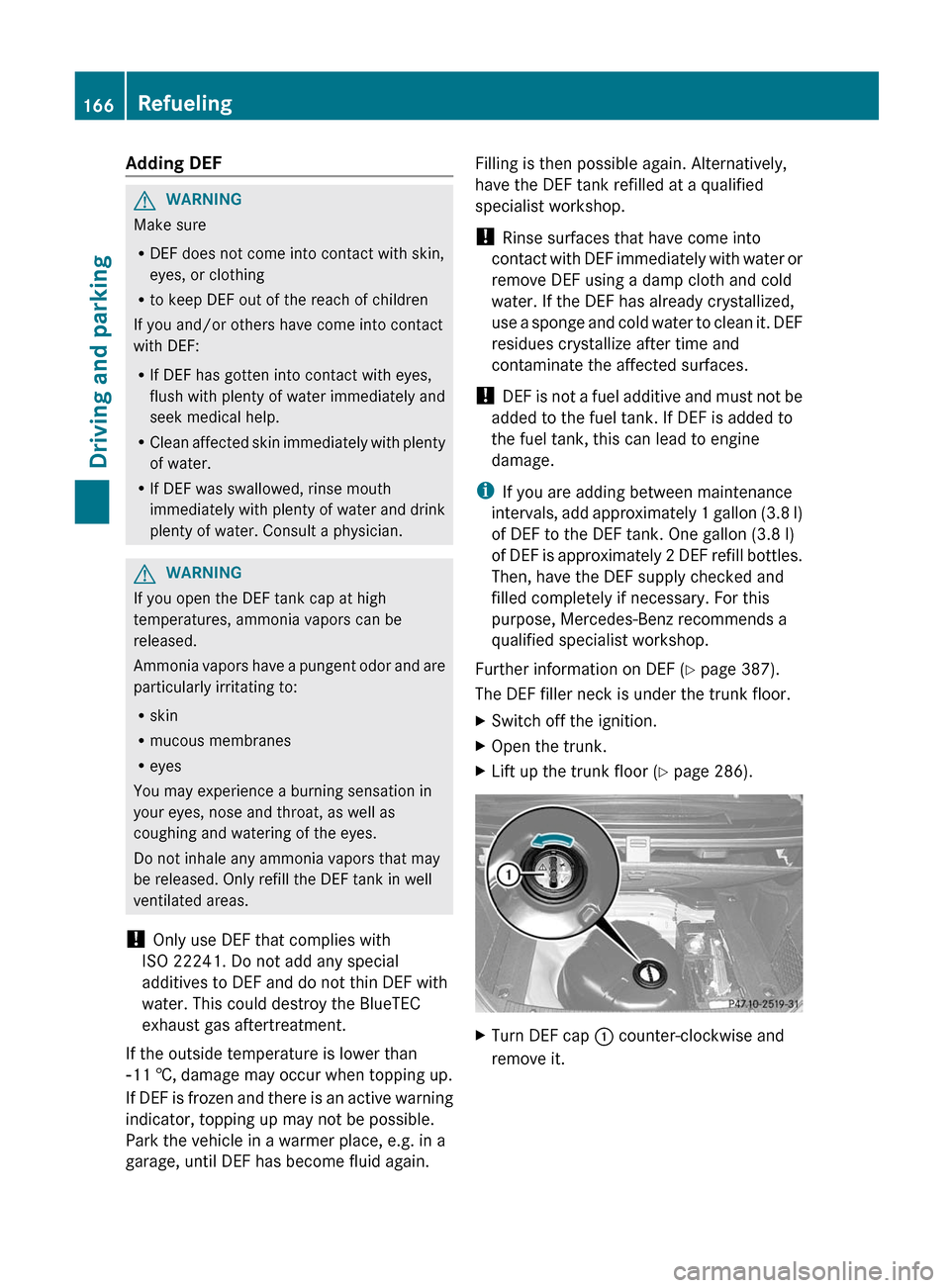
Adding DEFGWARNING
Make sure
R DEF does not come into contact with skin,
eyes, or clothing
R to keep DEF out of the reach of children
If you and/or others have come into contact
with DEF:
R If DEF has gotten into contact with eyes,
flush with plenty of water immediately and
seek medical help.
R Clean affected skin immediately with plenty
of water.
R If DEF was swallowed, rinse mouth
immediately with plenty of water and drink
plenty of water. Consult a physician.
GWARNING
If you open the DEF tank cap at high
temperatures, ammonia vapors can be
released.
Ammonia vapors have a pungent odor and are
particularly irritating to:
R skin
R mucous membranes
R eyes
You may experience a burning sensation in
your eyes, nose and throat, as well as
coughing and watering of the eyes.
Do not inhale any ammonia vapors that may
be released. Only refill the DEF tank in well
ventilated areas.
! Only use DEF that complies with
ISO 22241. Do not add any special
additives to DEF and do not thin DEF with
water. This could destroy the BlueTEC
exhaust gas aftertreatment.
If the outside temperature is lower than
Ò 11 †, damage may occur when topping up.
If DEF is frozen and there is an active warning
indicator, topping up may not be possible.
Park the vehicle in a warmer place, e.g. in a
garage, until DEF has become fluid again.
Filling is then possible again. Alternatively,
have the DEF tank refilled at a qualified
specialist workshop.
! Rinse surfaces that have come into
contact with DEF immediately with water or
remove DEF using a damp cloth and cold
water. If the DEF has already crystallized,
use a sponge and cold water to clean it. DEF
residues crystallize after time and
contaminate the affected surfaces.
! DEF is not a fuel additive and must not be
added to the fuel tank. If DEF is added to
the fuel tank, this can lead to engine
damage.
i If you are adding between maintenance
intervals, add approximately 1 gallon (3.8 l)
of DEF to the DEF tank. One gallon (3.8 l)
of DEF is approximately 2 DEF refill bottles.
Then, have the DEF supply checked and
filled completely if necessary. For this
purpose, Mercedes-Benz recommends a
qualified specialist workshop.
Further information on DEF ( Y page 387).
The DEF filler neck is under the trunk floor.XSwitch off the ignition.XOpen the trunk.XLift up the trunk floor ( Y page 286).XTurn DEF cap : counter-clockwise and
remove it.166RefuelingDriving and parking
Page 312 of 396
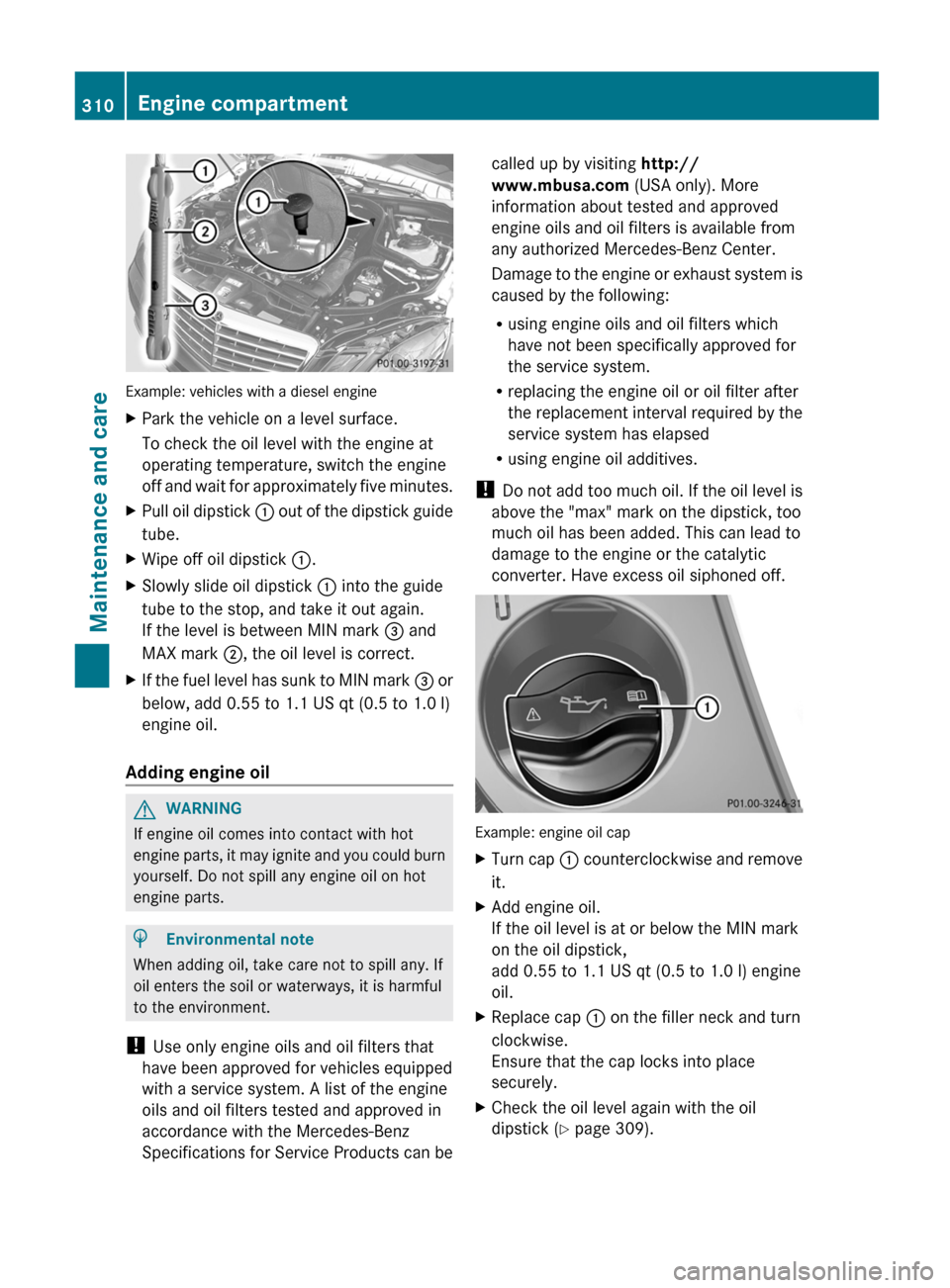
Example: vehicles with a diesel engine
XPark the vehicle on a level surface.
To check the oil level with the engine at
operating temperature, switch the engine
off and wait for approximately five minutes.XPull oil dipstick : out of the dipstick guide
tube.XWipe off oil dipstick :.XSlowly slide oil dipstick : into the guide
tube to the stop, and take it out again.
If the level is between MIN mark = and
MAX mark ;, the oil level is correct.XIf the fuel level has sunk to MIN mark = or
below, add 0.55 to 1.1 US qt (0.5 to 1.0 l)
engine oil.
Adding engine oil
GWARNING
If engine oil comes into contact with hot
engine parts, it may ignite and you could burn
yourself. Do not spill any engine oil on hot
engine parts.
HEnvironmental note
When adding oil, take care not to spill any. If
oil enters the soil or waterways, it is harmful
to the environment.
! Use only engine oils and oil filters that
have been approved for vehicles equipped
with a service system. A list of the engine
oils and oil filters tested and approved in
accordance with the Mercedes-Benz
Specifications for Service Products can be
called up by visiting http://
www.mbusa.com (USA only). More
information about tested and approved
engine oils and oil filters is available from
any authorized Mercedes-Benz Center.
Damage to the engine or exhaust system is
caused by the following:
R using engine oils and oil filters which
have not been specifically approved for
the service system.
R replacing the engine oil or oil filter after
the replacement interval required by the
service system has elapsed
R using engine oil additives.
! Do not add too much oil. If the oil level is
above the "max" mark on the dipstick, too
much oil has been added. This can lead to
damage to the engine or the catalytic
converter. Have excess oil siphoned off.
Example: engine oil cap
XTurn cap : counterclockwise and remove
it.XAdd engine oil.
If the oil level is at or below the MIN mark
on the oil dipstick,
add 0.55 to 1.1 US qt (0.5 to 1.0 l) engine
oil.XReplace cap : on the filler neck and turn
clockwise.
Ensure that the cap locks into place
securely.XCheck the oil level again with the oil
dipstick ( Y page 309).310Engine compartmentMaintenance and care
Page 384 of 396
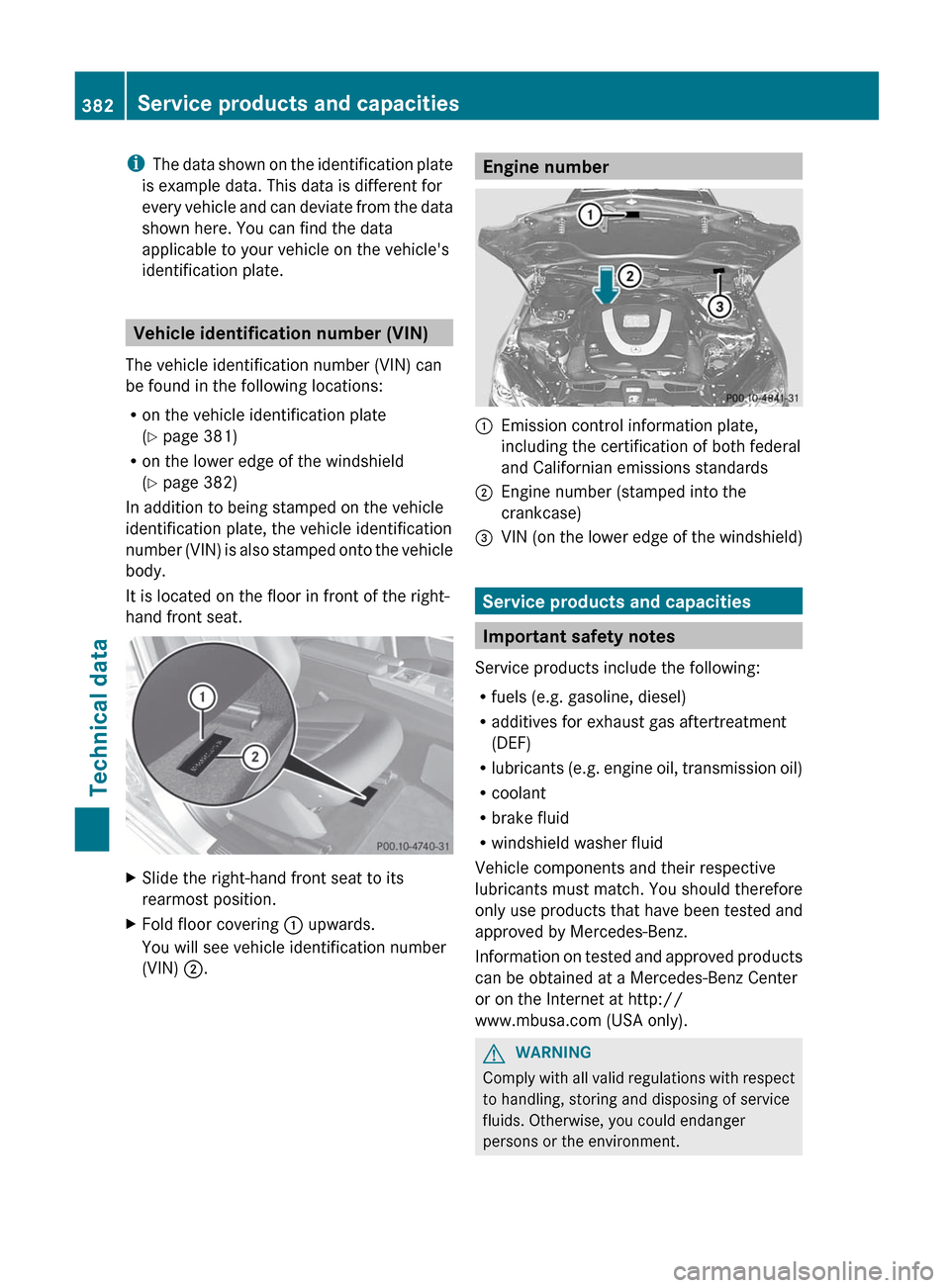
iThe data shown on the identification plate
is example data. This data is different for
every vehicle and can deviate from the data
shown here. You can find the data
applicable to your vehicle on the vehicle's
identification plate.
Vehicle identification number (VIN)
The vehicle identification number (VIN) can
be found in the following locations:
R on the vehicle identification plate
( Y page 381)
R on the lower edge of the windshield
( Y page 382)
In addition to being stamped on the vehicle
identification plate, the vehicle identification
number (VIN) is also stamped onto the vehicle
body.
It is located on the floor in front of the right-
hand front seat.
XSlide the right-hand front seat to its
rearmost position.XFold floor covering : upwards.
You will see vehicle identification number
(VIN) ;.Engine number:Emission control information plate,
including the certification of both federal
and Californian emissions standards;Engine number (stamped into the
crankcase)=VIN (on the lower edge of the windshield)
Service products and capacities
Important safety notes
Service products include the following:
R fuels (e.g. gasoline, diesel)
R additives for exhaust gas aftertreatment
(DEF)
R lubricants (e.g. engine oil, transmission oil)
R coolant
R brake fluid
R windshield washer fluid
Vehicle components and their respective
lubricants must match. You should therefore
only use products that have been tested and
approved by Mercedes-Benz.
Information on tested and approved products
can be obtained at a Mercedes-Benz Center
or on the Internet at http://
www.mbusa.com (USA only).
GWARNING
Comply with all valid regulations with respect
to handling, storing and disposing of service
fluids. Otherwise, you could endanger
persons or the environment.
382Service products and capacitiesTechnical data
Page 387 of 396
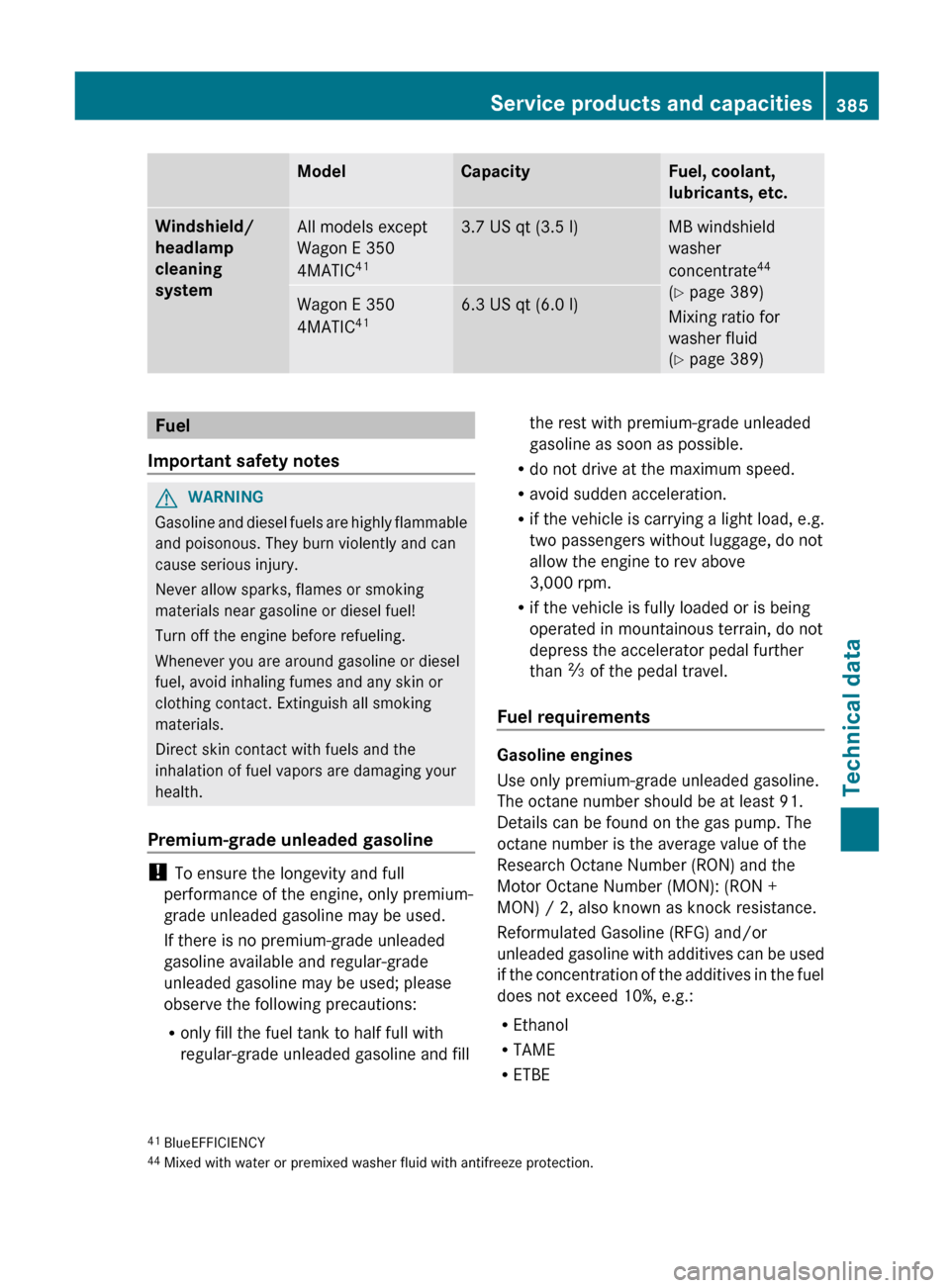
ModelCapacityFuel, coolant,
lubricants, etc.Windshield/
headlamp
cleaning
systemAll models except
Wagon E 350
4MATIC 413.7 US qt (3.5 l)MB windshield
washer
concentrate 44
( Y page 389)
Mixing ratio for
washer fluid
( Y page 389)Wagon E 350
4MATIC 416.3 US qt (6.0 l)Fuel
Important safety notesGWARNING
Gasoline and diesel fuels are highly flammable
and poisonous. They burn violently and can
cause serious injury.
Never allow sparks, flames or smoking
materials near gasoline or diesel fuel!
Turn off the engine before refueling.
Whenever you are around gasoline or diesel
fuel, avoid inhaling fumes and any skin or
clothing contact. Extinguish all smoking
materials.
Direct skin contact with fuels and the
inhalation of fuel vapors are damaging your
health.
Premium-grade unleaded gasoline
! To ensure the longevity and full
performance of the engine, only premium-
grade unleaded gasoline may be used.
If there is no premium-grade unleaded
gasoline available and regular-grade
unleaded gasoline may be used; please
observe the following precautions:
R only fill the fuel tank to half full with
regular-grade unleaded gasoline and fill
the rest with premium-grade unleaded
gasoline as soon as possible.
R do not drive at the maximum speed.
R avoid sudden acceleration.
R if the vehicle is carrying a light load, e.g.
two passengers without luggage, do not
allow the engine to rev above
3,000 rpm.
R if the vehicle is fully loaded or is being
operated in mountainous terrain, do not
depress the accelerator pedal further
than Ô of the pedal travel.
Fuel requirements
Gasoline engines
Use only premium-grade unleaded gasoline.
The octane number should be at least 91.
Details can be found on the gas pump. The
octane number is the average value of the
Research Octane Number (RON) and the
Motor Octane Number (MON): (RON +
MON) / 2, also known as knock resistance.
Reformulated Gasoline (RFG) and/or
unleaded gasoline with additives can be used
if the concentration of the additives in the fuel
does not exceed 10%, e.g.:
R Ethanol
R TAME
R ETBE
41BlueEFFICIENCY
44 Mixed with water or premixed washer fluid with antifreeze protection.Service products and capacities385Technical dataZ
Page 388 of 396
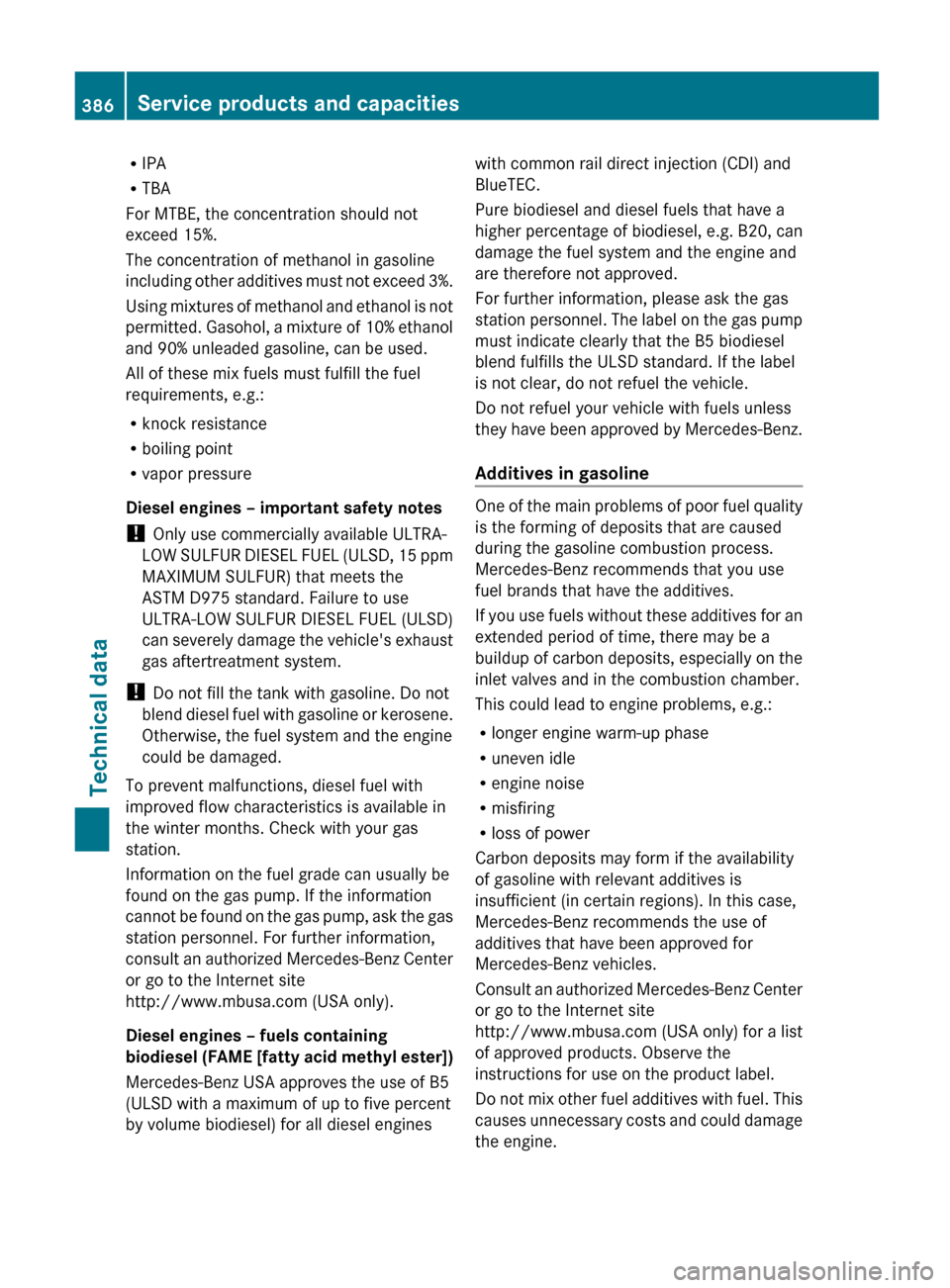
RIPA
R TBA
For MTBE, the concentration should not
exceed 15%.
The concentration of methanol in gasoline
including other additives must not exceed 3%.
Using mixtures of methanol and ethanol is not
permitted. Gasohol, a mixture of 10% ethanol
and 90% unleaded gasoline, can be used.
All of these mix fuels must fulfill the fuel
requirements, e.g.:
R knock resistance
R boiling point
R vapor pressure
Diesel engines – important safety notes
! Only use commercially available ULTRA-
LOW SULFUR DIESEL FUEL (ULSD, 15 ppm
MAXIMUM SULFUR) that meets the
ASTM D975 standard. Failure to use
ULTRA-LOW SULFUR DIESEL FUEL (ULSD)
can severely damage the vehicle's exhaust
gas aftertreatment system.
! Do not fill the tank with gasoline. Do not
blend diesel fuel with gasoline or kerosene.
Otherwise, the fuel system and the engine
could be damaged.
To prevent malfunctions, diesel fuel with
improved flow characteristics is available in
the winter months. Check with your gas
station.
Information on the fuel grade can usually be
found on the gas pump. If the information
cannot be found on the gas pump, ask the gas
station personnel. For further information,
consult an authorized Mercedes-Benz Center
or go to the Internet site
http://www.mbusa.com (USA only).
Diesel engines – fuels containing
biodiesel (FAME [fatty acid methyl ester])
Mercedes-Benz USA approves the use of B5
(ULSD with a maximum of up to five percent
by volume biodiesel) for all diesel engineswith common rail direct injection (CDI) and
BlueTEC.
Pure biodiesel and diesel fuels that have a
higher percentage of biodiesel, e.g. B20, can
damage the fuel system and the engine and
are therefore not approved.
For further information, please ask the gas
station personnel. The label on the gas pump
must indicate clearly that the B5 biodiesel
blend fulfills the ULSD standard. If the label
is not clear, do not refuel the vehicle.
Do not refuel your vehicle with fuels unless
they have been approved by Mercedes-Benz.
Additives in gasoline
One of the main problems of poor fuel quality
is the forming of deposits that are caused
during the gasoline combustion process.
Mercedes-Benz recommends that you use
fuel brands that have the additives.
If you use fuels without these additives for an
extended period of time, there may be a
buildup of carbon deposits, especially on the
inlet valves and in the combustion chamber.
This could lead to engine problems, e.g.:
R longer engine warm-up phase
R uneven idle
R engine noise
R misfiring
R loss of power
Carbon deposits may form if the availability
of gasoline with relevant additives is
insufficient (in certain regions). In this case,
Mercedes-Benz recommends the use of
additives that have been approved for
Mercedes-Benz vehicles.
Consult an authorized Mercedes-Benz Center
or go to the Internet site
http://www.mbusa.com (USA only) for a list
of approved products. Observe the
instructions for use on the product label.
Do not mix other fuel additives with fuel. This
causes unnecessary costs and could damage
the engine.
386Service products and capacitiesTechnical data
Page 389 of 396
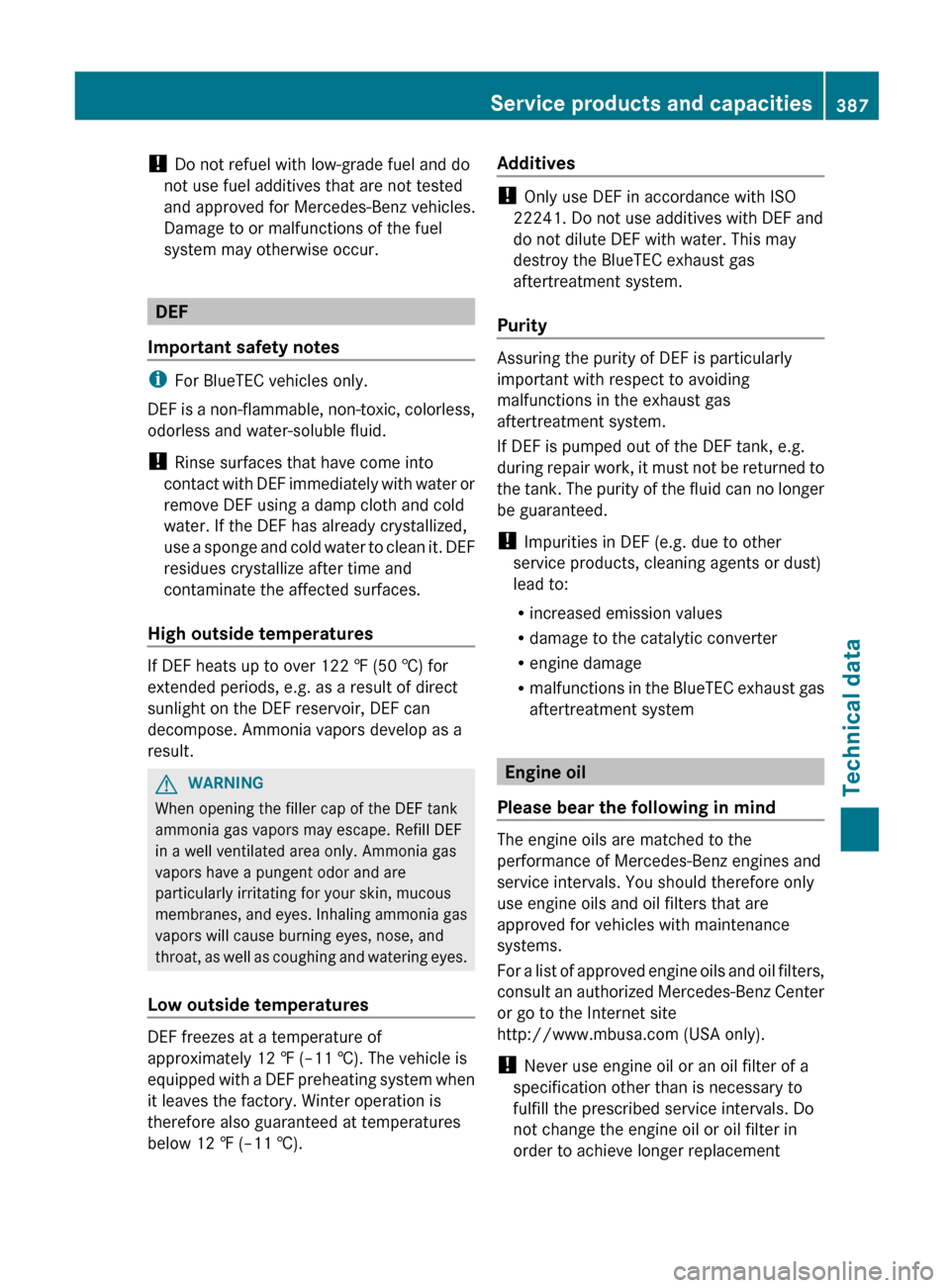
! Do not refuel with low-grade fuel and do
not use fuel additives that are not tested
and approved for Mercedes-Benz vehicles.
Damage to or malfunctions of the fuel
system may otherwise occur.
DEF
Important safety notes
i For BlueTEC vehicles only.
DEF is a non-flammable, non-toxic, colorless,
odorless and water-soluble fluid.
! Rinse surfaces that have come into
contact with DEF immediately with water or
remove DEF using a damp cloth and cold
water. If the DEF has already crystallized,
use a sponge and cold water to clean it. DEF
residues crystallize after time and
contaminate the affected surfaces.
High outside temperatures
If DEF heats up to over 122 ‡ (50 †) for
extended periods, e.g. as a result of direct
sunlight on the DEF reservoir, DEF can
decompose. Ammonia vapors develop as a
result.
GWARNING
When opening the filler cap of the DEF tank
ammonia gas vapors may escape. Refill DEF
in a well ventilated area only. Ammonia gas
vapors have a pungent odor and are
particularly irritating for your skin, mucous
membranes, and eyes. Inhaling ammonia gas
vapors will cause burning eyes, nose, and
throat, as well as coughing and watering eyes.
Low outside temperatures
DEF freezes at a temperature of
approximately 12 ‡ (–11 †). The vehicle is
equipped with a DEF preheating system when
it leaves the factory. Winter operation is
therefore also guaranteed at temperatures
below 12 ‡ (–11 †).
Additives
! Only use DEF in accordance with ISO
22241. Do not use additives with DEF and
do not dilute DEF with water. This may
destroy the BlueTEC exhaust gas
aftertreatment system.
Purity
Assuring the purity of DEF is particularly
important with respect to avoiding
malfunctions in the exhaust gas
aftertreatment system.
If DEF is pumped out of the DEF tank, e.g.
during repair work, it must not be returned to
the tank. The purity of the fluid can no longer
be guaranteed.
! Impurities in DEF (e.g. due to other
service products, cleaning agents or dust)
lead to:
R increased emission values
R damage to the catalytic converter
R engine damage
R malfunctions in the BlueTEC exhaust gas
aftertreatment system
Engine oil
Please bear the following in mind
The engine oils are matched to the
performance of Mercedes-Benz engines and
service intervals. You should therefore only
use engine oils and oil filters that are
approved for vehicles with maintenance
systems.
For a list of approved engine oils and oil filters,
consult an authorized Mercedes-Benz Center
or go to the Internet site
http://www.mbusa.com (USA only).
! Never use engine oil or an oil filter of a
specification other than is necessary to
fulfill the prescribed service intervals. Do
not change the engine oil or oil filter in
order to achieve longer replacement
Service products and capacities387Technical dataZ